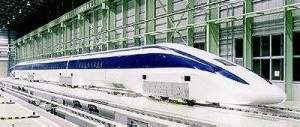Soon after Kamerlingh Onnes discovered superconductivity, scientists began dreaming up practical applications for this strange new phenomenon. Powerful new superconducting magnets could be made much smaller than a resistive magnet,because the windings could carry large currents with no energy loss. Generators wound with superconductors could generate the same amount of electricity with smaller equipment and less energy. Once the electricity was generated it could be distributed through superconducting wires. Energy could be stored in superconducting coils for long periods of time without significant loss.
in transport tech:

Magnetic-levitation is an application where superconductors perform extremely well. Transport vehicles such as trains can be made to “float” on strong superconducting magnets, virtually eliminating friction between the train and its tracks. Not only would conventional electromagnets waste much of the electrical energy as heat, they would have to be physically much larger than superconducting magnets. A landmark for the commercial use of MAGLEV technology occurred in 1990 when it gained the status of a nationally-funded project in Japan.
Although the technology has now been proven, the wider use of MAGLEV vehicles has been constrained by political and environmental concerns (strong magnetic fields can create a bio-hazard). The world’s first MAGLEV train to be adopted into commercial service, a shuttle in Birmingham, England, shut down in 1997 after operating for 11 years. A Sino-German maglev is currently operating over a 30-km course at Pudong International Airport in Shanghai, China.
in medical science:

An area where superconductors can perform a life-saving function is in the field of biomagnetism. Doctors need a non-invasive means of determining what’s going on inside the human body. By impinging a strong superconductor-derived magnetic field into the body, hydrogen atoms that exist in the body’s water and fat molecules are forced to accept energy from the magnetic field. They then release this energy at a frequency that can be detected and displayed graphically by a computer. Magnetic Resonance Imaging (MRI) was actually discovered in the mid 1940’s. But, the first MRI exam on a human being was not performed until July 3, 1977. And, it took almost five hours to produce one image! Today’s faster computers process the data in much less time.
The Korean Superconductivity Group within CRISS has carried biomagnetic technology a step further with the development of a double-relaxation oscillation SQUID (Superconducting QUantum Interference Device) for use in Magnetoencephalography. SQUID’s are capable of sensing a change in a magnetic field over a billion times weaker than the force that moves the needle on a compass With this technology, the body can be probed to certain depths without the need for the strong magnetic fields associated with MRI’s.
in Power Applications(High Tc):
Power applications of high temperature superconductors would have the major advantage of being able to operate at liquid nitrogen temperature. The biggest barrier to their application has been the difficulty of fabricating the materials into wires and coils. Current development focuses on BSCCO and YBCO materials.
in energy efficient devices:
The US Department of Energy are actively encourages the use of superconductors as energy efficient devices.
At the moment, the problem lies with the critical temperature – unless a material is found that can superconduct above 300K, some sort of cooling system needs to be employed, which would be expensive, although companies are developing prototypes – in December 1998, Pirelli Wire built a test 150ft cable that transmitted electricity using high temperature superconducting materials.
in particle accelerators:

Particle Colliders like CERN‘s Large Hadron Collider (LHC) are like very large running tracks that are used to accelerate particles (i.e. eletrons, positrons, hadrons and more) to speeds approaching the speed of light before they are collided with one another or other atoms, usually to split them (this was how many sub-nuclear particles such as taus and neutrinos were discovered).
They do this by cycling the particle using magnetic fields, continually increasing the speed of the particle.
The first project to use superconducting magnets was the proton-antiproton collider at Fermilab.
in fast electronic switches:
Type II superconductors can be used to as very fast electronic switches (as they have no moving parts), due to the way in which a magnetic field can penetrate into the superconductor – this has allowed Japanese researchers to build a 4-bit computer microchip (compared to today’s 32-bit and 64-bit processors) operating at about 500 times the speed of current processors, where heat output is currently a major problem with typical speeds approaching the 1GHz mark.
An article in Superconductor Week focuses upon the efforts of NASA, DARPA and others to build a ‘petaflop’ (a thousand-trillion floating point operations per second – compared to today’s ‘teraflop’ (1 trillion Flops per sec) computers) computer using superconductor technology.
